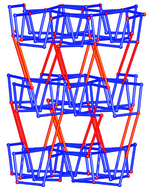Coligand-directed synthesis of five Co(ii)/Ni(ii) coordination polymers with a neutral tetradentate ligand: syntheses, crystal structures, and properties†‡
Abstract
The solvothermal reactions of 1,1′-oxybis[3,5-di-4-pyridine]-benzene (L) and transition metal cations (Co and Ni) afford five novel coordination polymers in the presence of flexible bridging ligands (4,4′-H2nba = 4,4′-dicarboxydiphenylamine, H2cam = D-camphoric acid, 4,4′-H2sdb = 4,4′-sulfonyldibenzoic acid, H2chdc = 1,4-trans-cyclohexanedicarboxylic acid), namely {[Co2L2(OH)2(nba)]·2DMF}n (1), {[CoL(cam)(H2O)]}n (2), {[Co3(L)(4,4′-sdb)3(H2O)]·1.5CH3CN·4H2O}n (3), {[Ni3(L)(4,4′-sdb)3(H2O)]·1.5CH3CN·4H2O}n (4), and {[Ni2L2(chdc)2(H2O)2]·(H2O)3}n (5) (DMF = N,N-dimethylformamide). Their structures have been determined by single-crystal X-ray diffraction analyses and further characterized by elemental analyses, IR spectroscopy, and powder X-ray diffraction. Complex 1 reveals a 2-fold interpenetrating three-dimensional (3D) framework with the Schläfli symbol {4·8·104}{4·8·10} topology. Compound 2 crystallizes in the achiral space group with the D-camphorate ligand racemized. Compounds 3 and 4 reveal similar structure with the {3·44·6}{32·48·59·69} topology based on a linear trinuclear building block M3(OOCR)6 (M = Co(II) or Ni(II)). Compound 5 is a wavy sheet, where both carboxylate and L ligands act as bidentate ligands. Moreover, UV-Visible absorption spectra of complexes 1–3, 5 and the magnetic properties of 3 have been investigated.


 Please wait while we load your content...
Please wait while we load your content...